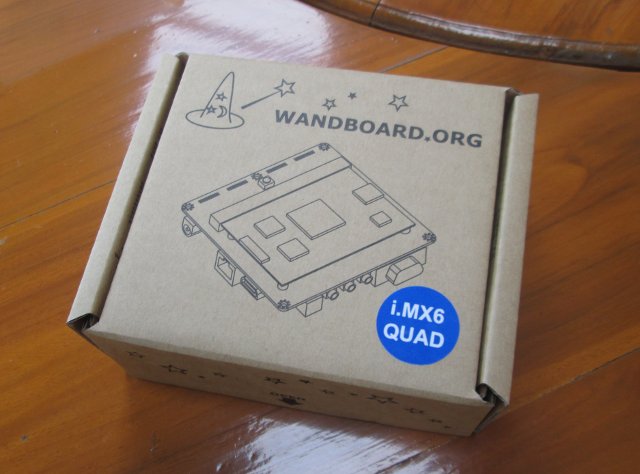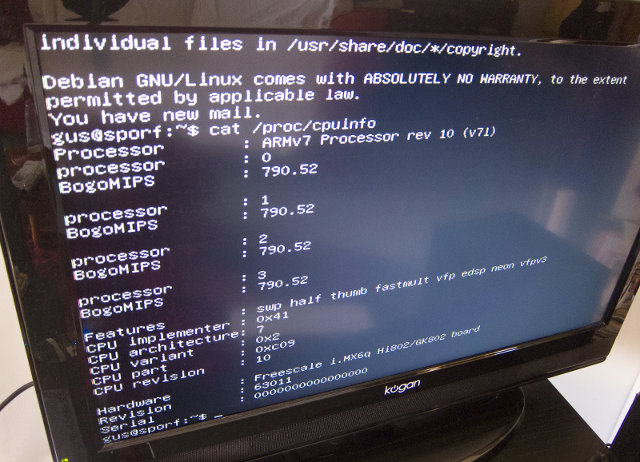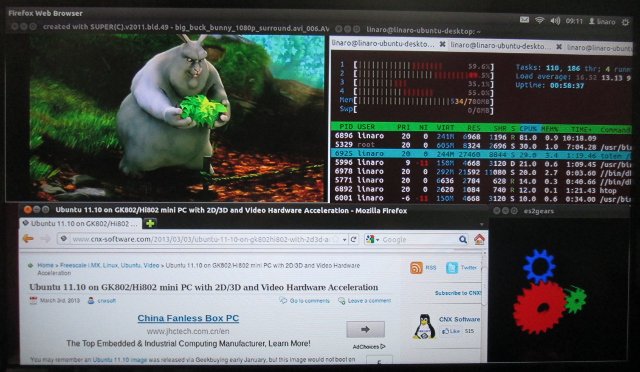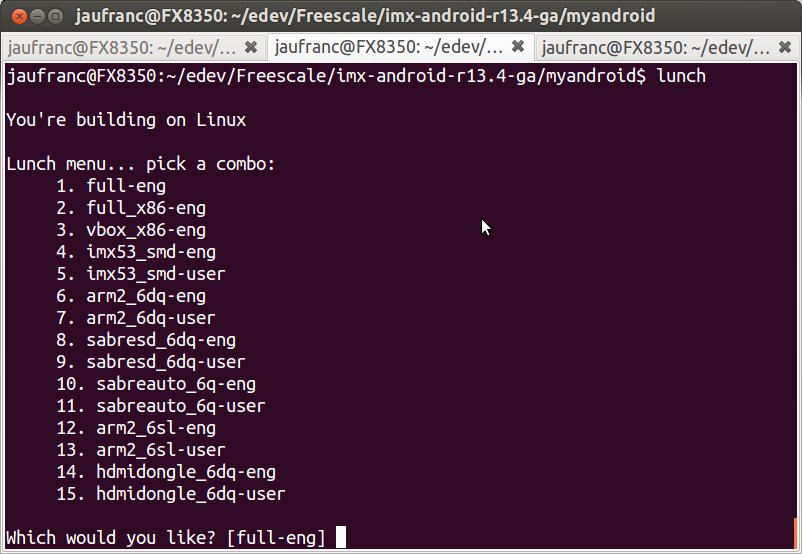After my review of the Wandboard Dual in February, I’ve now received Wanboard Quad development board powered by Freescale i.MX6 Quad Cortex A9 processor, with 2 GB RAM, HDMI output, Gigabit Ethernet, and SATA. The board is available from several distributors including Mouser ($139), DigiKey ($144.38) and FutureElectronics ($125). I’ll start by showing some unboxing pictures of the board, as well as pictures of Wandboard Dual and Quad side-by-side. Then I’ll explain how to install Android and Linux on the board, build the images from source, run some benchmarks, and test different features. Wandboard Quad Unboxing Ive received the board via UPS in a large box that contained the package below. This is exactly the same as Wandboard Dual, except for the sticker. There’s just the board inside the package, and it would just look like Wandboard Dual with all connectors on the top, and the EDM module at the back, […]
A Preliminary XBMC Image is now Available for Wandboard, GK802
Yesterday, Stephan Rafin left a message on Wandboard mailing list saying he had released a preliminary (Linux) XBMC image that can run on Wandboard Quad development board. GPU and VPU acceleration work, but this is still work in progress, so if you want something that just works, this is not for you. But if you just want to give it a try, it should work on any hardware based on Freescale i.MX6, such as Wandboard Dual or GK802 mini PC, with some minor modifications. If you’ve got a Wandboard Quad board, the installation is straightforward from a Linux machine: Download the SD card image Decompress it with xz or 7x:
|
1 |
7z x wand.bin.xz |
Dump the resulting to a 2GB or greater microSD card:
|
1 |
dd if=wand.bin of=/dev/sdx bs=4M |
Where /dev/sdx is the sdcard device (e.g. /dev/sdc). You can check with lsblk command. If you’ve got a machine running Windows only, you can use Win32DiskImager for step […]
Debian 7.0 Installer for Hi802 / GK802 mini PCs
We’ve had Ubuntu support on i.MX6 HDMI dongles, specifically HiApad Hi802 and Zealz GK802, for a little while, but for those who prefer Debian distribution, a Debian installer is now available thanks to Angus Gratton. Bear in mind that 2D/3D GPU acceleration is disabled in order to save 192MB RAM, as this image is mainly destined to server and/or robotic applications. If you need a desktop experience with GPU acceleration, you’d have to use Ubuntu, or you may try enable it in Debian, and see if it works, but this has not been tested. The instructions below are to be used with the internal microSD card, but if you’re ready to hack a bit around, it might be possible to run the installer from an external microSD or USB device thanks to Jasbir’s U-boot multiboot. You’d still need to use an internal microSD, but you’d only have to open the […]
Preliminary Ubuntu 12.04 RootFS for GK802/HI802 mini PC
After releasing a pretty good Ubuntu 11.10 image with both VPU and GPU acceleration for Freescale i.MX6 based HDMI dongles last month, Jasbir (aka jas-hacks) has released an Ubuntu 12.04 image with GPU support thanks to the help of Octavio (Yocto Project contributor), and Wi-Fi support. It’s possible to select Unity 2D or Xubuntu desktop, and Chromium and Neverball, a 3D ball game, are part of the image. There’s still more work however, as VPU (Video Processing Unit) support is work in progress, Bluetooth does not work yet, and OpenGL ES test programs such as glmark2-es2 or es2gears do not work properly with Xubuntu, even though they do work fine with Unity 2D. Jasbir uploaded a video showing Neverball 3D game in GK802, and it works pretty good, although the framerate does not seem optimal for now. If you want to give this image a try, install GK802 Ubuntu 11.10 […]
Ubuntu 11.10 Image for Hi802 / GK802 is Now Available for Download
About 2 weeks ago, Jasbir released an Ubuntu 11.10 image and installation instructions for GK802 and Hi802 mini PCs based on Freescale i.MX6. I could only find time to give it try yesterday and today. I’ll provide the steps I followed to install the image, and my quick first impressions of the stability and performance of this image. Installation Instructions I mainly followed the instructions provided by Jasbir, and run GParted to increased the partition size on my micro SD card. The image is for a 8 GB micro SD, but those instructions should work on 4GB SD card and greater, as the rootfs partition is only 3GB large. Download the Ubuntu 11.10 image, uboot, as well as the kernel image and modules in a Linux PC:
|
1 2 3 4 |
wget http://dl.miniand.com/jas-hacks/gk802/ubuntu_gk802.img.gz wget http://dl.miniand.com/jas-hacks/gk802/u-boot.imx wget http://dl.miniand.com/jas-hacks/gk802/uImage_3.0.35-0269_cpu_freq wget http://dl.miniand.com/jas-hacks/gk802/modules_3.0.35-02695.tar |
Copy the image, uboot and the kernel to the micro SD card by typing the commands below:
|
1 2 3 4 |
gzip -d ubuntu_gk802.img.gz sudo dd if=ubuntu_gk802.img of=/dev/<sd_device> sudo dd if=u-boot.imx bs=1k seek=1 of=/dev/<sd_device> && sync sudo dd if=uImage_3.0.35-0269_cpu_freq of=/dev/<sd_drive> bs=1048576 seek=1 && sudo sync |
Replace /dev/<sd_device> by your […]
Ubuntu 11.10 on GK802/Hi802 mini PC with 2D/3D and Video Hardware Acceleration
You may remember an Ubuntu 11.10 image was released via Geekbuying early January, but this image would not boot on my Hi802, lacked 2D/3D acceleration, and to my knowledge there hasn’t been any update since then. So hope of proper Linux support on the device was fading, until the community discovered Freescale released patches for i.mx6 HDMI dongles, developers setup the imx6-dongle community, and after a lot of work, mainly by three members: Jasbir, Dmitriy (rz2k) and James, there’s now GPU and VPU support on Ubuntu 11.10. Here’s a summary of the current status: Wifi working. External SD working Matched IOMUX configuration to align with the Android image. Stripped out unnecessary device initialisation from the original HDMI dongle source. Enabled EGL and GLES HW Acceleration in Ubuntu. Unity desktop might be partially HW accelerated (TBC) Jasbir uploaded a video to YouTube to show the progress, and it looks pretty good. […]
Developer Community for Freescale i.MX6 HDMI Dongles
Last week, I explained how to build U-boot, the kernel, and Android for Freescale i.MX6 HDMI dongle reference platform. Since them, there has been a bit more activity, with Richtechie releasing source code to some ARMTvTech members. However, this source code is very similar to the one released by Freescale, and misses some part present in the kernel config on GK802 such as CONFIG_MACH_MX6Q_RICHTECHIE, and the company clearly does not comply with the GPL. Let’s forget that for now, as Jasbir (who is also behind the Hackberry board) has managed to build and boot the kernel on his mini PC. There’s still more work to do, but at least we have a based to work on. In the meantime, I’ve noticed rz2k, an other developer, was also giving it a try on #arm-netbook Freenode IRC channel, so we decided to setup a few things to facilitate development and communication between developers. […]
U-boot, Linux Kernel, and Android Patches for Freescale i.MX6 HDMI TV Dongles
We can now get some quad core Android mini PCs (e.g. Hi802, GK802) featuring Freescale i.MX6Q processor, Freescale has released full documentation and source code its development platforms, Hi802 / GK802 HDMI TV dongles are easily hackable, and there’s even an Ubuntu image for the devices. So it looks pretty good ,right? Well almost.. there are some patches and config for GK802 that have not been released by Richtechie, so we can’t modify the bootloader and Linux kernel. But this may change, as ARMTvTech forum user hste noticed some Freescale i.MX6 HDMI dongle patches om IMX Community website. Even though I’m not sure those are fully compatible with Hi802 / GK802, this could be a starting point. Today, I’ll provide the instructions to build u-boot, the linux kernel and Android ICS with those patches in a machine running Linux 12.04 64-bit. Patch Sets Descriptions There are two set of patches that […]







